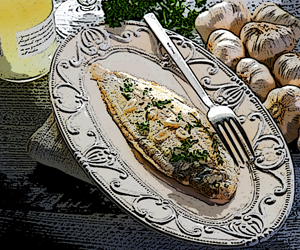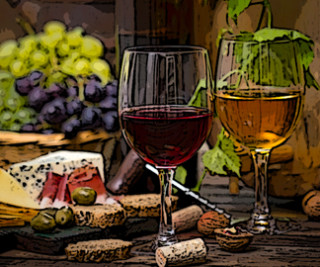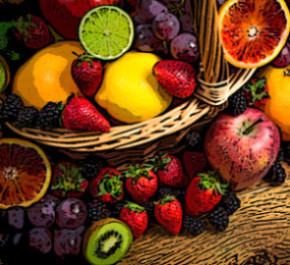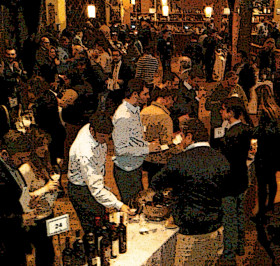The Cancellation Effect In Food And Wine Pairing.
Chapter Nine, Part Five.
 Matching food and wine by weight will put you in the ballpark when choosing the proper wine, but taste is the key to hitting an astronomic-gastronomic home run. Sweet, sour, salt, bitter, umami and piquance interact with one another in predictable ways and once you understand how these principles apply at your dining room table you’ll be able to create some major league food and wine combinations. I lump these interactions into three categories I call the cancellation effect, the cumulative effect, and the neutral effect.
Matching food and wine by weight will put you in the ballpark when choosing the proper wine, but taste is the key to hitting an astronomic-gastronomic home run. Sweet, sour, salt, bitter, umami and piquance interact with one another in predictable ways and once you understand how these principles apply at your dining room table you’ll be able to create some major league food and wine combinations. I lump these interactions into three categories I call the cancellation effect, the cumulative effect, and the neutral effect.
The WineSnark Academy for Sensory Testing, Evaluation & Debauchery (W.A.S.T.E.D.) On Food & Wine Pairing Principles.
Chapter Nine, Parts Two & Three.
 Shortly after WineSnark began its detailed research into taste perception it became apparent that an undertaking of this magnitude required a research team of dedicated, compassionate wine professionals, or as they’re known in the trade, drunks.
Shortly after WineSnark began its detailed research into taste perception it became apparent that an undertaking of this magnitude required a research team of dedicated, compassionate wine professionals, or as they’re known in the trade, drunks.
And so was born the WineSnark Academy for Sensory Testing, Evaluation and Debauchery (W.A.S.T.E.D.). We WASTED professionals do not take our research sitting down, as getting back up is often difficult, and because thousands of grapes have given their lives to further our understanding of human physiology, biochemistry, sensory perception and stuff.
Read MoreTerroir; From Great Vines Come Great Wines.
Chapter Eleven. Part Three.
Gerald Asher, A Vineyard in My Glass
 There’s an expression among winemakers that says, “95% of every wine is made in the vineyard.” This simply means that despite the best efforts of man to manipulate wine, its quality ultimately depends on the grapes they start with. Unless of course man takes his 5% and really screws things up, in which case he’ll remind us that 95% of the wine is made in the vineyard. And in case you’re wondering, that’s the vineyard where sour grapes come from.
There’s an expression among winemakers that says, “95% of every wine is made in the vineyard.” This simply means that despite the best efforts of man to manipulate wine, its quality ultimately depends on the grapes they start with. Unless of course man takes his 5% and really screws things up, in which case he’ll remind us that 95% of the wine is made in the vineyard. And in case you’re wondering, that’s the vineyard where sour grapes come from.
In Other Words – Euphemisms In Wine Journalism.
Chapter Six, Part One.
 Once you’ve learned to decipher wine’s elusive qualities you may also need some tips on how to express your observations. In addition to the correlation between the flavors found in wine and the flavors found in your average fruit basket, you’ll want to describe wine’s appearance, texture, weight, oak, and umm … what’s that other one? Oh yeah, arsenic.
Once you’ve learned to decipher wine’s elusive qualities you may also need some tips on how to express your observations. In addition to the correlation between the flavors found in wine and the flavors found in your average fruit basket, you’ll want to describe wine’s appearance, texture, weight, oak, and umm … what’s that other one? Oh yeah, arsenic.
We turn to wine critics for help with these thorny descriptors because they are so much more than mere wine aficionados. That’s right, wine critics are also self-aggrandizing blowhards. No wait! That’s not it! I meant to say they are also writers.
Read MoreLife Worth Living Starts With Wine Worth Drinking.
I‘ve always been inspired by Eleanor Roosevelt, who once said, “You must do the things you think you cannot do.” I took her advice to heart and I’m happy to report that I’m back at my laptop now that I’ve made bail.
Speaking of bail, last year I reviewed several wines from the Massanois trade tasting and I was able to attend again this year due to a glaring lapse in security. I only tasted the domestic wines this year because those are the wineries I wanted to pester into giving me a job. I’ve been ungainfully employed as a blogger since selling The Wine Seller last year but at least they let me keep the computer, the tax records, and the ulcer.
Read More




















